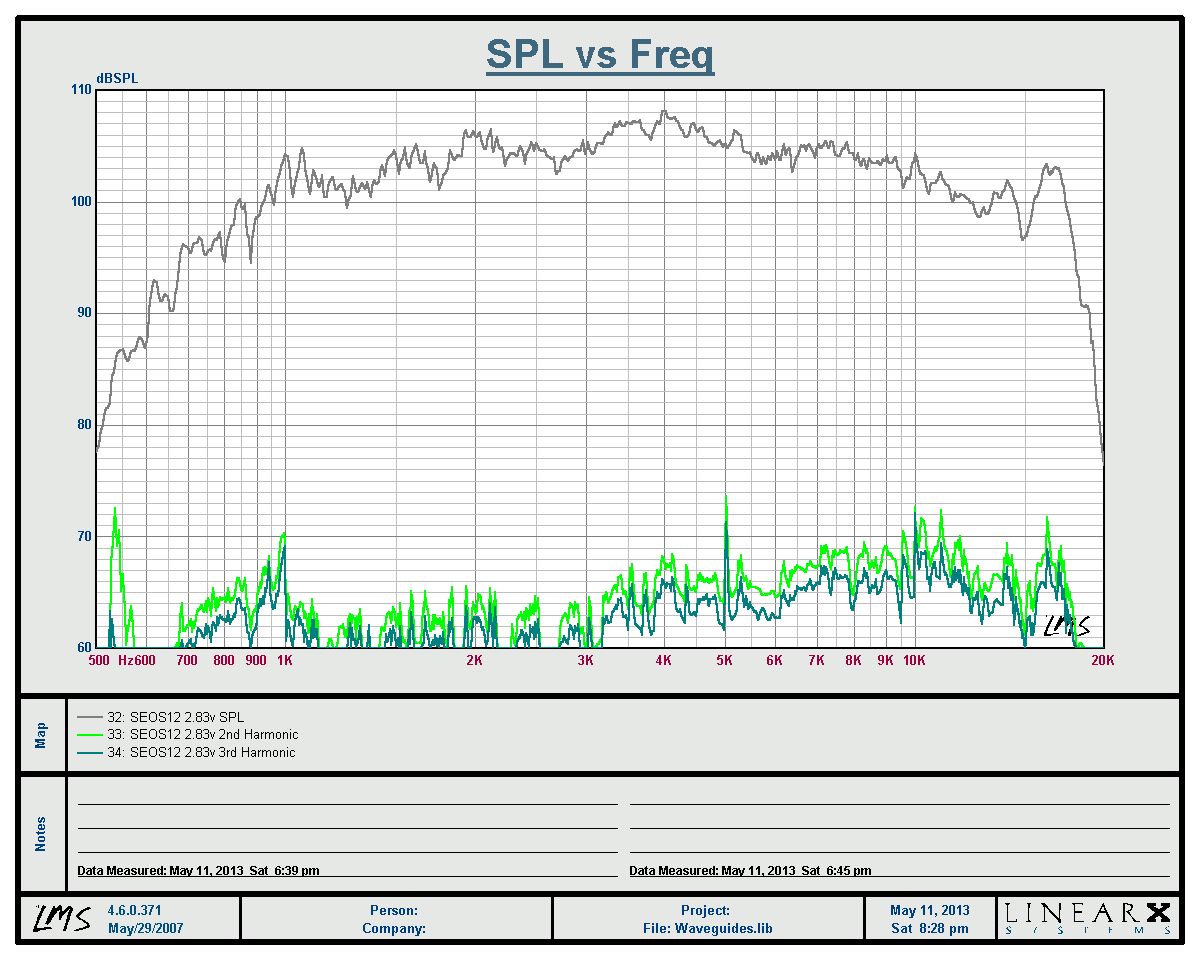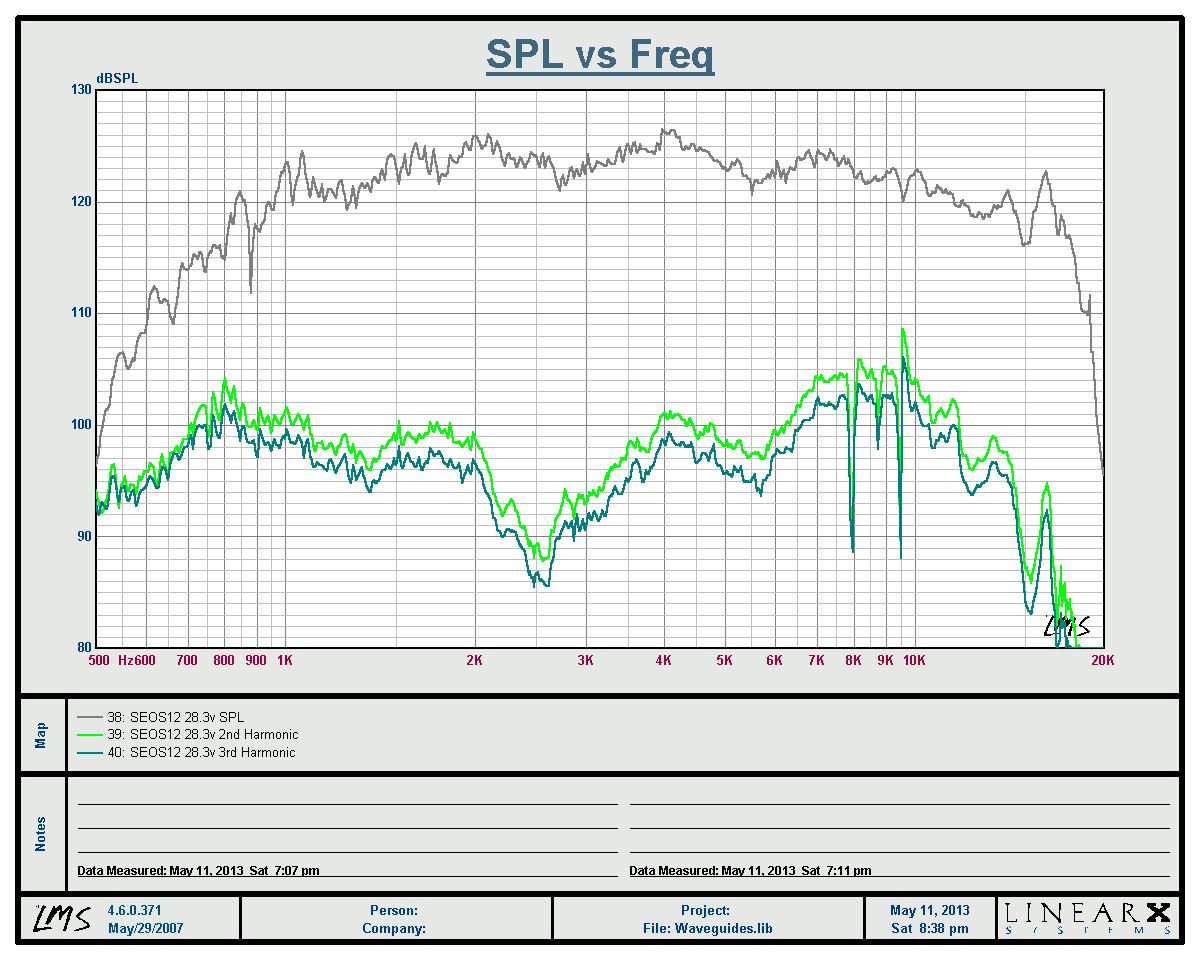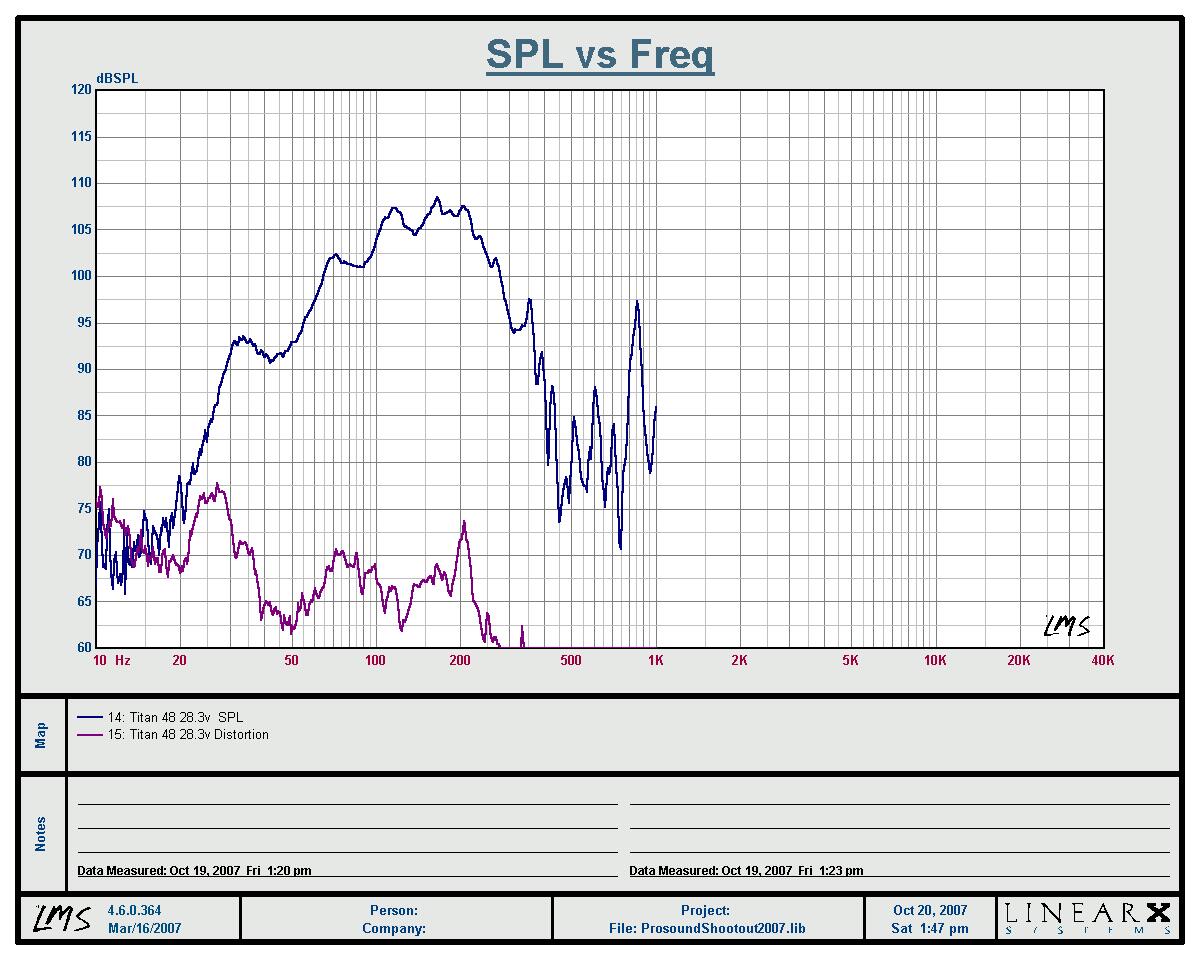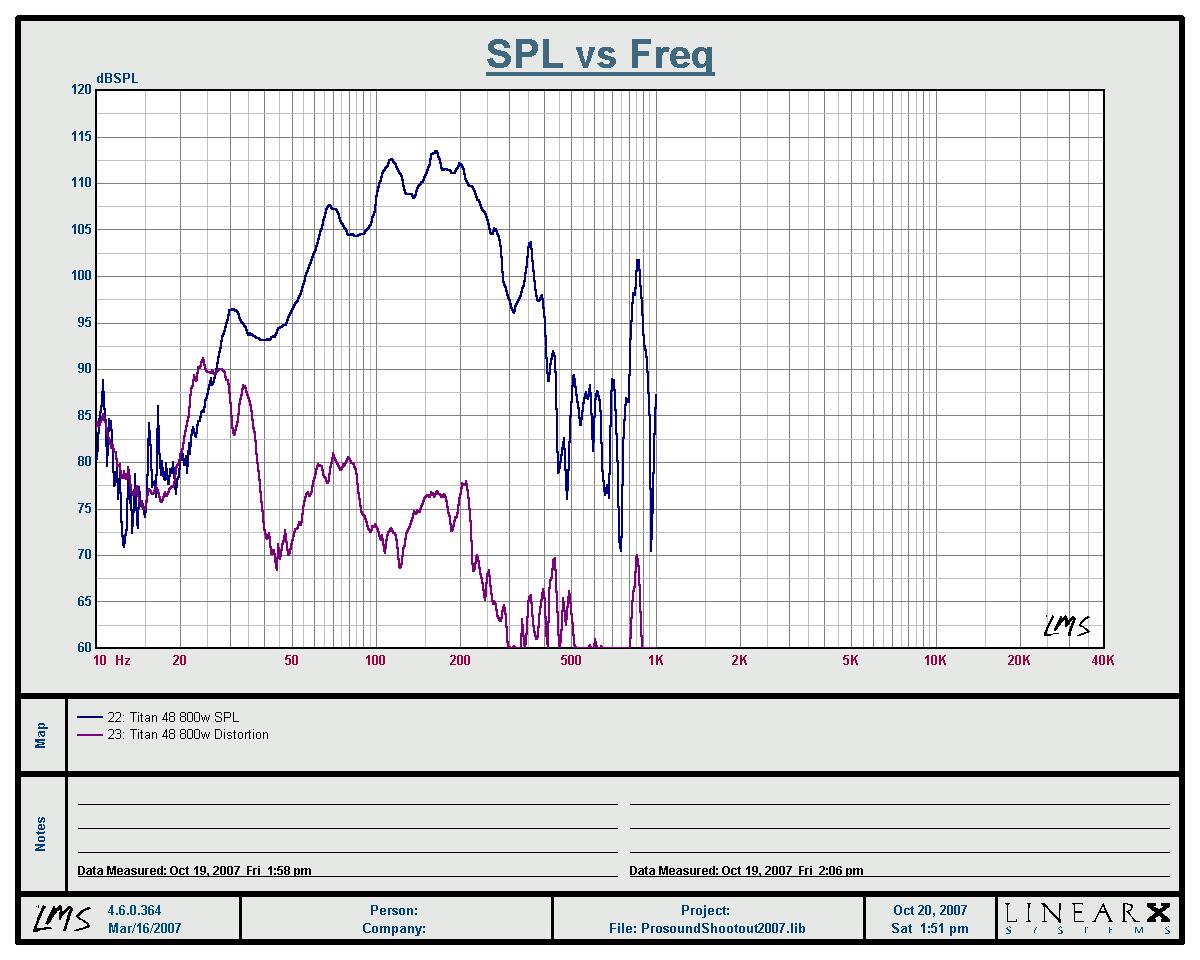Wayne - all horn/driver devices have peaks.
Yes, and some are worse than others. I guess I should have qualified that statement by saying if a horn has greater than about 3dB peaks in its passband, I won't use it. If it needs EQ beyond the basic mass-rolloff conjugate, if it has peaks that one would "fix" with tank circuits, it's not for me.
Any "electro-mechanical parameters shift " is going to be insignificant. Tank circuits work just fine - you used to suggest them! At any rate, your argument is extremely weak and not at all in line with what I have found. You would have to support what you are saying with some data as I do not see it as reasonable.
I have never used notch filters in any loudspeaker I have designed. I do mention them in many of my writings about crossovers, but just to show how they can be used for things like this.
As for electrical parameter shifts, they are most definitely real, and fairly significant. It strikes me a bit odd that you would be concerned about thermal modulation, yet dismiss the effects on response.
Some systems shift greatly as voice coil resistance changes at higher temperature. Others shift less. In general, I find the shifts in woofers to be larger than compression drivers, but I do find the response shift quite detectable in compression drivers too.
Here's an example. Look at the two response charts below, the ones showing a compression driver on a horn. Download them to your computer and click between them rapidly so you can see how the shape of the ripple changes at higher power levels. Then look at the two charts of a basshorn below that. It shows what I'm talking about even more.
Compression driver on a horn:


Cone driver in a basshorn:




Cone driver in a basshorn:


Last edited:
Please explain to me how a temperature change will change the frequency of a resonance. There will be a slight change in the level from thermal effects as the coil resistance changes or the magnetic field drops, but these are fairly small changes and the tank circuits are still "tuned" to the correct frequency.
I have done these power tests (frequency response as a function of power level) on my speakers - remember they were originally designed for Pro applications - and found that while there were some changes they were only a few dB - at peak power levels! The greatest changes were actually in the passive circuits themselves where the coils would sometimes melt. Larger coils would, of course have prevented this, as would an active crossover, but the point is that at its absolute worst it is not a problem that would make the use of tank circuits ill advised.
It is important to keep the problems in perspective.
I have done these power tests (frequency response as a function of power level) on my speakers - remember they were originally designed for Pro applications - and found that while there were some changes they were only a few dB - at peak power levels! The greatest changes were actually in the passive circuits themselves where the coils would sometimes melt. Larger coils would, of course have prevented this, as would an active crossover, but the point is that at its absolute worst it is not a problem that would make the use of tank circuits ill advised.
It is important to keep the problems in perspective.
Yes, and some are worse than others. I guess I should have qualified that statement by saying if a horn has greater than about 3dB peaks in its passband, I won't use it.
My waveguides have almost no peaking in them at all, but the drivers themselves have peaks - at least two - at the lower edge of their pass-band. All compression drivers have at least two peaks in their electrical impedance even if put on a PWT. They will tend to have these same two peaks in the SPL depending on the nature of the crossover used and these often do exceed 3 dB. They will never be non-existent. Hence some means of correction must be used if one want the +- 2dB response that I look for.
If there are more than two peaks in the electrical impedance then the horn itself is resonate and I would never use it.
I have done these power tests (frequency response as a function of power level) on my speakers - remember they were originally designed for Pro applications - and found that while there were some changes they were only a few dB - at peak power levels!
This is in line with the measurements I posted. We see a few decibels change in the ripple at high power levels compared to low. Some cases are worse than others, with just a couple decibels difference in the best cases and as much as six decibels in some of the more "shifty" worst-case systems. But in all cases, there is thermal shift.
And I might add, this is an instantaneous condition. It doesn't require heat soak at all. The peaks are there instantaneously, or at least within a few cycles. This may be part of the thermal modulation we were talking about earlier.
My waveguides have almost no peaking in them at all... If there are more than two peaks in the electrical impedance then the horn itself is resonate and I would never use it.
That's good to hear, Earl. We differ in opinion a little bit on the importance of the vertical nulls, but I didn't think we differed on the importance of reducing midband resonance peaking. I can almost bear the narrow spread between vertical nulls of your speakers, as long as I don't shift vertically while listening. But I cannot bear the resonant peaks in the response curve of any speaker that has them, They're nasty sounding, with "horn honk" of the highest magnitude!
And I might add, this is an instantaneous condition. It doesn't require heat soak at all. The peaks are there instantaneously, or at least within a few cycles. This may be part of the thermal modulation we were talking about earlier.
You would have to explain how the test was done to prove this as I don't think that it is easy to accomplish. A few seconds maybe, that's what my tests were, but "instantaneous"? That takes some doing to measure correctly, even if it is the case. I mean some time period for the measurement is required, even if its several ms.
I should also mention that I did some similar tests with typical speakers (well regarded ones I should add) using a 1" tweeter. The changes were on the order of 3 - 6 dB over a few seconds. These small tweeters are all over the place with power level. This has to be an audible factor. Compared to a 1" direct radiating tweeter, a compression driver is rock solid. We have to keep this in mind when discussing data like this.
I can't tolerate horn resonances either. This is, of course, where they get their bad reputation. A good device just does not sound anything like a bad horn.
Compared to a 1" direct radiating tweeter, at the same SPL, a compression driver is rock solid.I should also mention that I did some similar tests with typical speakers (well regarded ones I should add) using a 1" tweeter. The changes were on the order of 3 - 6 dB over a few seconds. These small tweeters are all over the place with power level. This has to be an audible factor. Compared to a 1" direct radiating tweeter, a compression driver is rock solid. We have to keep this in mind when discussing data like this.
We have to keep SPL in mind when discussing data like this, as compression driver/horn combinations certainly are not "rock solid" when driven to their thermal limits.
We differ in opinion a little bit on the importance of the vertical nulls ...
I also differ on the claim that they are any better or worse with an elliptical device versus a circular one. According to my calculations this is not the case. The nulls would be better for the elliptical if and only if the two devices held the vertical beamwidth over the same bandwidth. But the elliptical can't do that unless it is as tall as the circular one and then it has the same problem. If it is not as tall, then the vertical polars widen and collapse later in frequency and now lie within the crossover region. This creates a broader range of interference and a much less desirable resultant vertical response at the crossover. Hence, its more than simply the importance of the effect that we disagree on, I differ on the degree of the effect as well as its importance. In essence I have not found, and I have examined this, that a narrow elliptical device is a better choice than an axisymmetric one. The widely held opinions that it is are simply wishful thinking.
The narrower device does allow for a shorter cabinet, but that's about all. Acoustic performance enhancements are simply not there.
I have examined several elliptical devices and they do, as expected, have seveer compromises in the vertical directivity. No one shows this in their data, but it is there for anyone that looks. And if you look across a diagonal things get really bad. They look good only in the horizontal and fall apart everywhere else. People need to understand this.
Muddling
Were it that presentation will you find a claim that:
The issues are the metrics used to measure it and the variance in the threshold of perception, not that it is "not audible".
“There you go again”! Still more “muddling”.
I doubt it!Bill
Your attempts to obscure the issues astound me.
You referred to Voishvillo’s work:Voishvillo's conclusions and ours are virtually identical and even his process is identical to what we did. And yet you seem to be trying to present it as a rebuttal to what I have said when in fact it completely supports it.
So, I simply attached his presentation on the issues here.Our results have been replicated by others - Voishvillo at JBL for example.
Were it that presentation will you find a claim that:
You cannot "prove” your claim, because distortion due to system nonlinearity can be heard by some listeners under certain conditions."Nonlinear distortion" is not audible, we proven this with a rather elaborate study which was peer reviewed. Get informed on the literature.
The issues are the metrics used to measure it and the variance in the threshold of perception, not that it is "not audible".
For those that challenge you, it is always their “muddling” that gets in your way.Discussing anything with you just becomes an attempt to dig through your muddling of the issues.
You are the one who made the initial comparison.Comparing my study to Darwin's is so absurd as to be laughable - you completely missed the point.
I found it to be an amusing segue to divert the discussion to some religious experience about beliefs without “proof”. And the "truth" may be found where?Just like evolution has not been "proven". Some people just refuse to accept the truth.
Excuse Me! But, your permission is not required, and you are not the only one that has data to evaluate.Go ahead and believe what you believe, with no data to support it, and I will follow the data.
“There you go again”! Still more “muddling”.
Compared to a 1" direct radiating tweeter, at the same SPL, a compression driver is rock solid.
We have to keep SPL in mind when discussing data like this, as compression driver/horn combinations certainly are not "rock solid" when driven to their thermal limits.
Yes, of course, but it is SPL that we are creating and that has to be a basis for comparison. It would make no sense to listen and compare one speaker at 80 dB to the other at 100 dB.
Even at their thermal limits I would bet on a compression driver being far more stable that a 1" tweeter. The fact that these two limits are at least 20-30 dB apart just makes the argument stronger.
distortion due to system nonlinearity can be heard by some listeners under certain conditions.
Just like a religious extremist you go to the extremes to make a point. Of course anyone can create "certain conditions" for which nonlinearity is audible. My point is that one can also create a system for which it is not audible (within non-extreme conditions). I choose to do the latter, so naturally that's what I use as a basis for my claim. If all you design is junk then I guess I would worry about nonlinearity as well.
You would have to explain how the test was done to prove this as I don't think that it is easy to accomplish. A few seconds maybe, that's what my tests were, but "instantaneous"? That takes some doing to measure correctly, even if it is the case. I mean some time period for the measurement is required, even if its several ms.
OK, good, yes. I agree. The sweep takes more than a few seconds, and so to make the statement that it is "instantaneous" is a bit of a leap.
But just a bit, not much. You'll notice the first resonant mode of the horn is low, and this is nearly where the sweep starts. It is within a second, or was in my case. Still, I take your point that we don't know precisely how much time is required to heat the coil enough to create peaking. We only know that it happens. We must assume that the length of time is set by things like thermal mass and dissipation ability, etc.
Again, this follows the "thermal modulation" stuff that everyone was talking about earlier. Now that I think about it, the discussion wasn't in this thread. So for continuity, here's a link to it:
- Uniform Directivity - How important is it? (Segues into discussion about thermal effects)
I should also mention that I did some similar tests with typical speakers (well regarded ones I should add) using a 1" tweeter. The changes were on the order of 3 - 6 dB over a few seconds. These small tweeters are all over the place with power level. This has to be an audible factor. Compared to a 1" direct radiating tweeter, a compression driver is rock solid. We have to keep this in mind when discussing data like this.
Yes, I agree. I've measured a handful of different kinds of devices and found this trend in what I saw too. The best stuff had 2dB shifts, the worst had about 6dB shifts.
I can't tolerate horn resonances either. This is, of course, where they get their bad reputation. A good device just does not sound anything like a bad horn.
Agreed, 100%. In fact, I think that's the number one biggest offender, the thing that most often makes people describe a resonant horn as having "horn honk."
But since a properly designed waveguide/horn can be made with very little ripple to begin with, why are we even talking about ways to mitigate ripple in the crossover? Make the waveguide right to begin with.
You said yours has less than 2dB ripple, as does mine. Problem solved.
And to the point of this thread - Don't install adapters if they increase ripple. If they're matched well, they can be done smoothly but if not, they can really degrade sound quality. An adapter is part of the overall flare profile, after all.
I would say that most often what is described as horn honk is simply to much gain in the lower frequencies caused by loading and horn gain that is not corrected by the crossover topology. When an end user simply has a second order high pass passive filter attached before the horn in question I would expect this comment about horn honk. Correct for the higher output at the 1/4 wave loading and the tilt from rolloff due to the mass loading at higher frequencies and most of the complaints of problems with horns will be much less common. Nothing that anybody doing PA work wouldn't be aware of.
But since a properly designed waveguide/horn can be made with very little ripple to begin with, why are we even talking about ways to mitigate ripple in the crossover? Make the waveguide right to begin with.
Again, it's the two resonances that are in the driver - the principle diaphragm resonance and the resonance caused by the air gap and the throat mass. These two resonances are always present - always. I use two tank circuits to level these off and there is one more to calm a resonance across the mouth, but it is a very low Q and low level. I do not see how you cannot have at least two tank circuits when a compression driver is used.
Correct for the higher output at the 1/4 wave loading and the tilt from rolloff due to the mass loading at higher frequencies and most of the complaints of problems with horns will be much less common. Nothing that anybody doing PA work wouldn't be aware of.
I can't agree with that- I've heard heavily EQ'd horn systems still have what I think of as the "bad horn sound". I don't know that "honk" is the right word but certainly there's a "sheen" on the sound that's quite upleasant. I believe smooth edge termination and limited diffraction are key to achieving this.
The JBL 4430 is less horn-like than some, but still had that bad characteristic to my ears. I blame the diffraction slot!
Again, it's the two resonances that are in the driver - the principle diaphragm resonance and the resonance caused by the air gap and the throat mass. These two resonances are always present - always. I use two tank circuits to level these off and there is one more to calm a resonance across the mouth, but it is a very low Q and low level. I do not see how you cannot have at least two tank circuits when a compression driver is used.
The second resonance you speak of is shifted by the horn, itself. Mount the driver on an exponential horn, for example, and that peak will shift way down in frequency. In conicals and catenary waveguides, it will be found higher in frequency, depending on the wall angle. And in some horns, there are resonances above that point, which are even more problematic.
The first peak is usually below the crossover point, and so it is attenuated beyond audibility. The second peak might be, and if so, it is usually also not troublesome. But if that peak gets close to the crossover point or is above it, then it must be damped. You could use a notch filter if you wanted, but I wouldn't for the reasons I described. In my opinion, it is better to use a non-resonating damper.
The second resonance you speak of is shifted by the horn, itself. Mount the driver on an exponential horn, for example, and that peak will shift way down in frequency. In conicals and catenary waveguides, it will be found higher in frequency, depending on the wall angle. And in some horns, there are resonances above that point, which are even more problematic.
The first peak is usually below the crossover point, and so it is attenuated beyond audibility. The second peak might be, and if so, it is usually also not troublesome. But if that peak gets close to the crossover point or is above it, then it must be damped. You could use a notch filter if you wanted, but I wouldn't for the reasons I described. In my opinion, it is better to use a non-resonating damper.
The first resonance does depend slightly on the mass loading from the horn (more so the mass of the drivers throat since its flare rate is very low), but these are not as varied as you might think, so the differences from horn to horn are not that great. In my speakers this peak is very near the crossover point and if it is not attenuated it messes up the acoustic response of the crossover. An OS waveguide has a very low mass so this peak tends to be on the high side. The second peak will virtually always be within the passband unless one designs for an extremely high crossover, which would be dumb given that the maximum output occurs at this peak.
I mitigate the vertical polar issue that you describe by using very low crossover points and so I tend to operate right at these two resonances. Crossing higher makes life easier, but it is not the ideal situation, just the easy one.
"Non-resonating damper" - is that a Wayne invention? I have never heard of such a thing and cannot imagine how it works. Care to explain?
- Status
- This old topic is closed. If you want to reopen this topic, contact a moderator using the "Report Post" button.
- Home
- Loudspeakers
- Multi-Way
- Waveguide adapters bad idea?